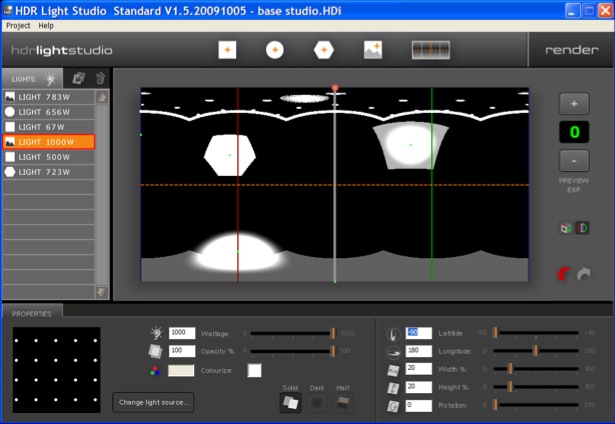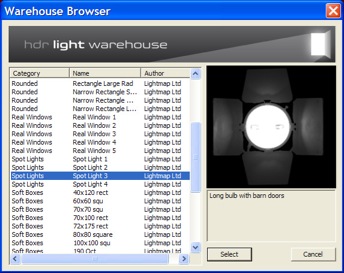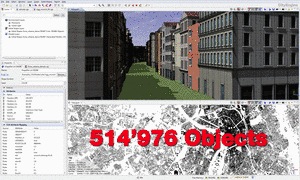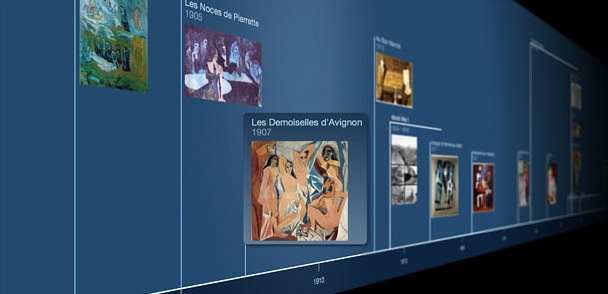HDR Light Studio 1.5 Review
12/10/09 09:19 Filed in: Review
by Albert Kiefer | Visual Designer | Venlo
The developers at HDR LightStudio have just released version 1.5 and I was very quick to buy it. Too bad it's still PC only since I work mainly on the Apple Macintosch platform. But since there are some essential packages that run exclusively on the PC I have a PC just for that purpose as well.
I have eagerly anticipated this new release of the software. I ordered my copy yesterday and even after playing just a very little while with it I am totally blown away with it. There will be no turning back now.
What does it do?
So what does HDR Light Studio actually do? In essence it is a kind of interactive HDR image composer. Anybody working with 3D software for visual design, product presentations, product visuals, etc will have worked with High Dynamic Range Images on occasion. HDR images contain a much higher level of image information than normal texturemaps. This extra information can be put to good use in Image based rendering programs like Hypershot, 3D Studio Max, Cinema 4D, Maya, Houdini and many more.
HDR Lightstudio enables you to interactively create your very own HDR studio images by placing light sources from a library on a virtual environment that is then mapped out to a flat image that can be rendered as an .HDR file or .EXR file format.

Creating flexible and complex lighting setups in HDR Light Studio 1.5 is very easy with the realtime feedback interface.
How does it do it?
When you start up HDR Light Studio you are presented with a fixed windo layout that has an area where you can compose the HDR image. This image area is basically the flattend projection of either a cube face or spherical environment. Left of the working area is the light or objects list that contains the current items that are mapped onto your environment in order of their creation (bottom item was created first and higher items in the stack created later.
The bottom row area contains information about the currently active light object. It shows the position attributes of the current light on the map and a whole section of light attributes like size, color, falloff, transparency. Every time you select another object from the items list you get direct parameter feedback in the information area.
Adding a new light object is as easy as clicking one of light icons in the top row of the interface. You have a choice of three procedural light types: round, rectangular and hexagon. There is also a fourth category which is image based. Here you can pick from a preset library of (HDRI) photographic light sources that were created from real world studio references and some that are more abstract. This type of light is available in the form of HDRI Light Packs that are available for purchase. Beware that the basic version of HDR Light Studio does not support this type of light though! the Standard and Pro versions of the software do support this image type and come pre bundled with a small set of LightPack images. More of these add on Lightpacks can be bought on-line soon.
You even have the choice to work with dark lights which remove light from an area of the image.

The HDR Light Studio 1.5 warehouse browser quickly show real world HDR based lighting objects
How does it feel working with it?
Working with HDR Light Studio 1.5 is a breeze. It just does its thing really well and give you results very fast. There is no guess work since feedback is instantaneous. You can choose to drag your light source into position on the mapped layout or enter values numerically as you watch the selected light object jump exactly into the correct position.
You are always in control. The really cool thing is to see the automatic projected deformation when you drag you sources around. When something is mapped onto a sphere it distorts based on its location relative to the spherical layout and HDR Light Studio does that all in realtime.
Is there room for improvement?
Sure there is. HDR Light Studio could even be much more of a killer application than it already is by adding some features that strangely lack from this version but should be in there.
First some interface improvements. Currently the window is a fixed layout that surprised me a bit in this large screen display era. I would have expected to be able to drag my interface to fully fit my screen area or maximize it with a single click. Unfortunately it was not possible. Nothing really bad but still. Being able to work larger makes placing elements a lot more under my control even when I prefer to drag around.
Another small interface glitch is that the cursor always remains the iconic text cursor which is funny since, apart from editing values, nothing here is text based. It should be a small effort to make the cursor change according to its current function. And talking about cursor behaviour: please make it possible to direct select light objects in the layout area (right mouse click or whatever). It's a bit of a nuissance to have to go to the list and do it there since sometimes you may have guessed wrong and selected the wrong one.
Having the Abillity to enter name tags to lightsources would also be welcome as an organizational means.
Feature wise there are some small but very nice additions that would really put some icing on an an already very tasty cake.
Very first on the list would be the ability to change the stacking order of the light list. Sometimes I have added a light earlier but would like a new lightsource to be behind that light. Now there no way to actually swap things layer wise. You have to delete all the layers and then rebuild. A simple way to drag the layer stack items around (Photoshop, etc) would solve this.
Another good addition would be the ability to add procedural light arrays. Suppose I want a ceiling made up of an array of 3 rows of ten lights each, or a grid of 4 by 4 lights. Impossible now but would be a nice and welcome addition.
Last, and probably not so easy to do, would be the addition of a preview area where you can see a realtime render of an object ( with selectable material properties) that is lit by the HDR map that you are building. In the current age of high performance systems that is not an impossible feat (look at Hypershot and the general trend towards more realtime rendering solutions with instant feedback). After all you make an HDR map to actually control your rendered 3D scene in a very substantial way and having more of a predictive overview of the map you are building will greatly enhance its effectiveness.
Where can you get it?
You can download a demo version of HDR Light Studio or you can immediately buy your copy in one of the available flavours here.
The prices range from a very acceptable 149 UK Pounds for the 1.5 Basic version to 299 UK Pounds for the Standard version to 499 UK pounds for the Pro version. Being able to author your own custom HDRI lighting rigs will save you money and allow you the flexibility of finetuning the maps for every new project. If you do 3D visualizations for products that require studio lit environments this will, in any form, repay itself quickly.
Update
I was just contacted by company CEO Mark Segasby of HDR Light Studio and friendly pointed to a couple of oversights on my part. Firstly you can select lights by using the Up and DOWN arrow keys to move through the list of lights in the scene. Although this may be practicle for some it still forces you through a serial way of cycling through your objects and it does not offer much benefit over the selection in the left objects list. Direct selection is just more practical and a lot more direct and faster.
The second remark is points to the fact that once you issue a "command-left SHIFT-Up or DOWN arrow" key command you can actually change the stacking order of the light objects.
CityEngine 2009.2 procedural modeler released
16/09/09 11:01 Filed in: News
New CityEngine 2009.2 Version Available Now for Download!
Significant improvements in performance allow for the design and modeling of megacities with over 500'000 buildings.

Procedural Inc. today announced the CityEngine 2009.2, the latest version of its groundbreaking software for the fast creation, visualization and analysis of large 3D cities. The software is used by high-profile companies such as Foster+Partners, Microsoft, Navteq, Boeing, IBM, Thales, Blizzard, Square Enix, etc. and was awarded Killer Technology 2009 by 3D World magazine Procedural Inc., an innovative software company located in Zurich, Switzerland, is creator of the world’s foremost procedural modeling technology. With the CityEngine, Procedural Inc.’s graphics experts have developed a radically different 3D application that allows professional users in entertainment, architecture and urban planning to efficiently design cities. "CityEngine 2009.2 introduces significant improvements in performance and overall stability", says Pascal Mueller, CEO Procedural Inc. "Furthermore, with the integration of map projection standards and corresponding accuracy enhancements, the CityEngine is now, together with its unique reporting functionality, the perfect tool for sustainable urban planning such as accurate simulation and evaluation of new city developments."
Key Highlights of the CityEngine 2009.2
- Large Data Set Support (over 500'000 buildings on 64bit)
- Map Projections (over 80 projections are supported)
- Accuracy Enhancements (enabling high-precision at global scale )
- 3DS Export (plus advancements of Collada and FBX export)
Pricing and Availability
A free 30-day trial version is available for download. The software can be purchased via Procedural Inc.’s website, or by telephone order at +41 76 720 3303. The CityEngine retails from a starting price of $ 3’450.
Beedocs Adds Support for Basecamp Project Management Software
15/09/09 16:11 Filed in: News

BEEDOCS (Apple only) today announced that Bee Docs Timeline 3D software for Mac OS X will support built-in integration with Basecamp project management software by 37signals. Bee Docs Timeline 3D received an Apple Design Award for "Best Mac OS X Leopard Application - Runner Up" in 2008.
"Project managers have told us that 3D timeline presentations are a great way to communicate project status with team members and customers," said Adam Behringer, creator of Bee Docs Timeline 3D. "Basecamp project management software users can now chart their project messages, to-do lists, and milestones directly from Bee Docs Timeline 3D in just a few clicks.
You can download demo movies and a demo version of Beedocs.
StormHand Nominated for Dutch Design Award
07/09/09 16:01 Filed in: News

To see the news flash on Dutch trade magazine Adformatie please follow this link.
You can also head straight to the page on the StormHand website containg the nominated packaging for Atelier LaDurance by clicking here. There's lots of information on the whole branding and branding strategy of Atelier LaDurance created by Boy Bastiaens.
Gridiron Flow Updated to version 1.0.1
06/09/09 12:26 Filed in: News
File and asset management tool Flow from Gridiron Software has been updated to version 1.0.1.
Here’s a rundown of changes from their release notes:
Flow Release Notes
Flow Version 1.0.1
Build: 12959
09|02|2009 05:23:PM
1. If you used a previous version of Flow...
IMPORTANT: There should be no need to recreate your database or your FlowData folders. If you choose to keep your data when you uninstall, the new install of Flow should allow you to use the data generated with the last build.
2. Platform Support
This release adds support for Mac OS X 10.6 - "Snow Leopard". For additional information about supported platforms, check out our website at:
http://www.gridironsoftware.com/products/flow/flow_techspecs.html
3. Application and File Format Support
Check out our supported applications and file formats on our website at:
http://www.gridironsoftware.com/products/flow/flow_techspecs.html
Adobe Distiller
Adobe Distiller is now a supported application.
Adobe InDesign Books
Adobe InDesign books have improved support in Flow 1.0.1
Adobe Acrobat
Flow can now track the Export Multiple Files capability of Adobe Acrobat.
Notepad & File Copy Tracking on Windows
Flow will now properly track file operations using the Notepad application on Windows. Flow will also properly track file copy operations using Explorer on Windows where many small files are copied.
4. New and Changed Functionality since Flow 1.0.0
• Share Maps - You can now host Share Maps and files referenced by Share Maps on file systems that are local to one Flow user/machine but exported as a share to other users.
• Welcome Screen - To help new users, a new modal dialog has been added that comes up over the main Flow UI that explains how to do some things in Flow. This screen hosts html content from the GridIron Software website so it can be updated.
• Sample Project - Flow now includes a sample project that you can navigate to see what Flow can do.
• Package Maps - Fixed a problem whereby Package Map folders that were moved, would lose access to their file versions and thumbnails.
• Activation - Fixed a few different activation problems including improved error reporting. In particular, activating on a Mac whose system volume is configured using software RAID, no longer fails.
• Performance - Fixed a defect whereby the tracking of an export link could cause a 2 second CPU spike.
• Numerous stability bug fixes and performance improvements.
5. Known Issues
For up to date view of any known issues check out our website at:
http://www.gridironsoftware.com/support/index.html
Here’s a rundown of changes from their release notes:
Flow Release Notes
Flow Version 1.0.1
Build: 12959
09|02|2009 05:23:PM
1. If you used a previous version of Flow...
IMPORTANT: There should be no need to recreate your database or your FlowData folders. If you choose to keep your data when you uninstall, the new install of Flow should allow you to use the data generated with the last build.
2. Platform Support
This release adds support for Mac OS X 10.6 - "Snow Leopard". For additional information about supported platforms, check out our website at:
http://www.gridironsoftware.com/products/flow/flow_techspecs.html
3. Application and File Format Support
Check out our supported applications and file formats on our website at:
http://www.gridironsoftware.com/products/flow/flow_techspecs.html
Adobe Distiller
Adobe Distiller is now a supported application.
Adobe InDesign Books
Adobe InDesign books have improved support in Flow 1.0.1
Adobe Acrobat
Flow can now track the Export Multiple Files capability of Adobe Acrobat.
Notepad & File Copy Tracking on Windows
Flow will now properly track file operations using the Notepad application on Windows. Flow will also properly track file copy operations using Explorer on Windows where many small files are copied.
4. New and Changed Functionality since Flow 1.0.0
• Share Maps - You can now host Share Maps and files referenced by Share Maps on file systems that are local to one Flow user/machine but exported as a share to other users.
• Welcome Screen - To help new users, a new modal dialog has been added that comes up over the main Flow UI that explains how to do some things in Flow. This screen hosts html content from the GridIron Software website so it can be updated.
• Sample Project - Flow now includes a sample project that you can navigate to see what Flow can do.
• Package Maps - Fixed a problem whereby Package Map folders that were moved, would lose access to their file versions and thumbnails.
• Activation - Fixed a few different activation problems including improved error reporting. In particular, activating on a Mac whose system volume is configured using software RAID, no longer fails.
• Performance - Fixed a defect whereby the tracking of an export link could cause a 2 second CPU spike.
• Numerous stability bug fixes and performance improvements.
5. Known Issues
For up to date view of any known issues check out our website at:
http://www.gridironsoftware.com/support/index.html